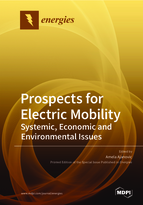Prospects for Electric Mobility: Systemic, Economic and Environmental Issues
A special issue of Energies (ISSN 1996-1073). This special issue belongs to the section "C: Energy Economics and Policy".
Deadline for manuscript submissions: closed (22 January 2021) | Viewed by 60086
Special Issue Editor
Special Issue Information
Dear Colleagues,
The transport sector currently shows the highest growth in greenhouse gas emissions but has demonstrated few approaches to solving this problem. Today, the most promising of these is electric mobility. Electric battery vehicles are already popular for passenger transport, but even more successful has been the use of electricity in public transport, where electric motors are already widely used. In principle, electric mobility may be a realistic solution to resolve these problems.
This Special Issue of Energies focuses on the future prospects and impediments of electric mobility. In detail, it highlights the systemic, economic, and environmental aspects of this topic, as well as the supporting policy development. Additional aspects of interest are the sources used for electricity generation and their environmental impact. Papers addressing any of these specific topics are welcome.
Dr. Amela Ajanovic
Guest Editor
Manuscript Submission Information
Manuscripts should be submitted online at www.mdpi.com by registering and logging in to this website. Once you are registered, click here to go to the submission form. Manuscripts can be submitted until the deadline. All submissions that pass pre-check are peer-reviewed. Accepted papers will be published continuously in the journal (as soon as accepted) and will be listed together on the special issue website. Research articles, review articles as well as short communications are invited. For planned papers, a title and short abstract (about 100 words) can be sent to the Editorial Office for announcement on this website.
Submitted manuscripts should not have been published previously, nor be under consideration for publication elsewhere (except conference proceedings papers). All manuscripts are thoroughly refereed through a single-blind peer-review process. A guide for authors and other relevant information for submission of manuscripts is available on the Instructions for Authors page. Energies is an international peer-reviewed open access semimonthly journal published by MDPI.
Please visit the Instructions for Authors page before submitting a manuscript. The Article Processing Charge (APC) for publication in this open access journal is 2600 CHF (Swiss Francs). Submitted papers should be well formatted and use good English. Authors may use MDPI's English editing service prior to publication or during author revisions.
Keywords
- electric mobility
- promotion policies
- economics
- greenhouse gas emissions
- embedded emissions
- life-cycle analyses
- systemic view
- electricity generation
- renewable energy
- energy efficiency






